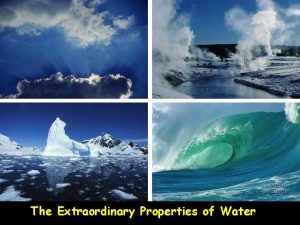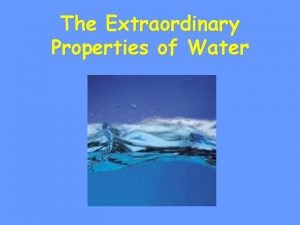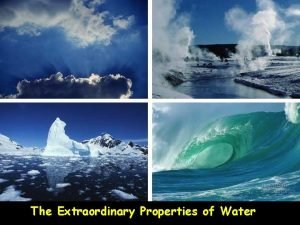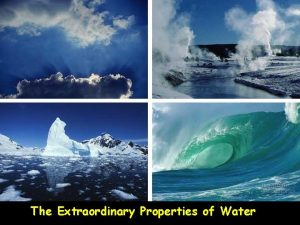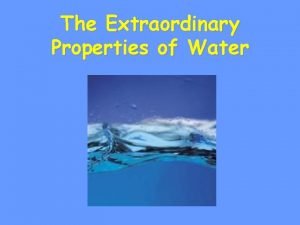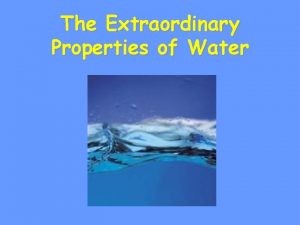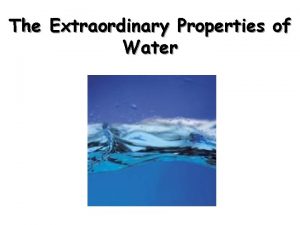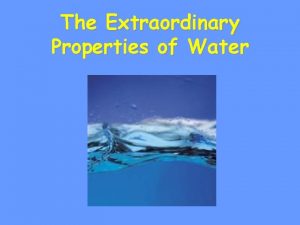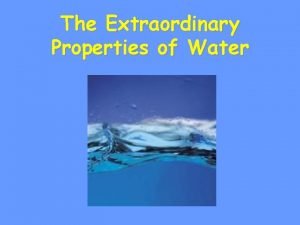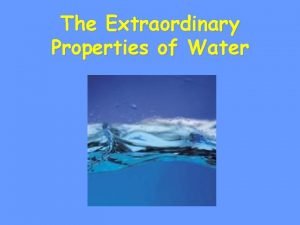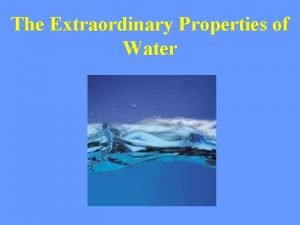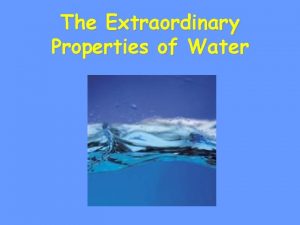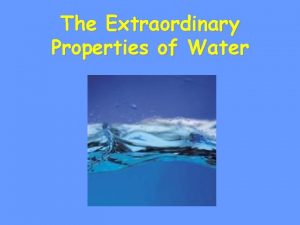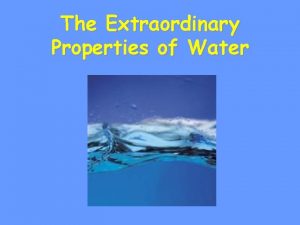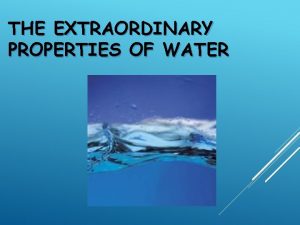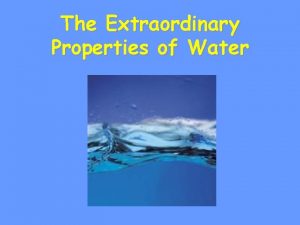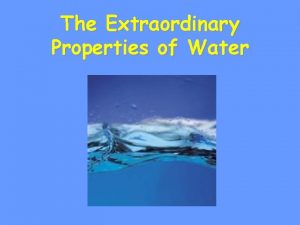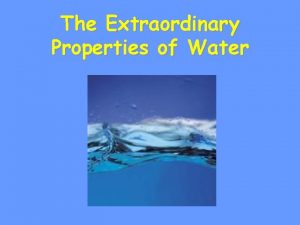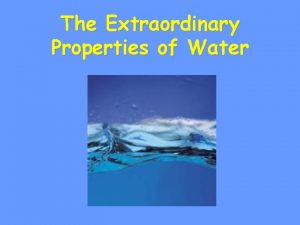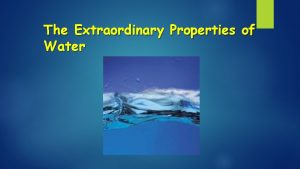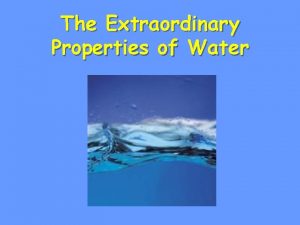The Extraordinary Properties of Water Water A water





























- Slides: 29

The Extraordinary Properties of Water

Water • A water molecule (H 2 O), is made up of three atoms --one oxygen and two hydrogen. H O H

Water is Polar • In each water molecule, the oxygen atom attracts more than its "fair share" of electrons • The oxygen end “acts” negative • The hydrogen end “acts” positive • Causes the water to be POLAR • However, Water is neutral (equal number of e- and p+) --- Zero Net Charge

Hydrogen Bonds Exist Between Water Molecules • Formed between a highly Electronegative atom of a polar molecule and a Hydrogen • One hydrogen bond is weak , but many hydrogen bonds are strong

Interaction Between Water Molecules Negative Oxygen end of one water molecule is attracted to the Positive Hydrogen end of another water molecule to form a HYDROGEN BOND

What are the Properties of Water?

Properties of Water • At sea level, pure water boils at 100 °C and freezes at 0 °C. • The boiling temperature of water decreases at higher elevations (lower atmospheric pressure). • For this reason, an egg will take longer to boil at higher altitudes

Properties of Water • Cohesion

Properties of Water • Cohesion • Adhesion

Properties of Water • Cohesion • Adhesion • High Specific Heat

Properties of Water • Cohesion • Adhesion • High Specific • High Heat of Heat Vaporization

Properties of Water • Cohesion • Adhesion • High Specific Heat • High Heat of Vaporization • Less Dense as a Solid

Cohesion • Attraction between particles of the same substance • Results in Surface tension (inward force or pull that minimizes the surface area of the liquid) • Produces a surface film on water that allows insects to walk on the surface of water

Cohesion … Helps insects walk across water

Surfactants • Wetting agent • Interferes with H-bonding of water • Reduces surface tension • Examples are soaps and detergents

Adhesion • Attraction between two different substances. • Water will make hydrogen bonds with other surfaces such as glass, soil, plant tissues, and cotton. • Capillary action-water molecules will “tow” each other along when in a thin glass tube. • Example: transpiration process which plants and trees remove water from the soil, and paper towels soak up water.

Adhesion Causes Capillary Action Which gives water the ability to “climb” structures

Adhesion Also Causes Water to … Form spheres & hold onto plant leaves Attach to a silken spider web

High Specific Heat • Amount of heat needed to raise or lower 1 g of a substance 1° C. • Water resists temperature change, both for heating and cooling. • Water can absorb or release large amounts of heat energy with little change in actual temperature.

High Specific Heat • Water stabilizes air temperatures by absorbing heat from warmer air and releasing heat to cooler air. • Water can absorb or release relatively large amounts of heat with only a slight change in its own temperature.

Three-fourths of the earth is covered by water. The water serves as a large heat sink responsible for: 1. Prevention of temperature fluctuations that are outside the range suitable for life. 2. Coastal areas having a mild climate 3. A stable marine environment

High Heat of Vaporization • Amount of energy to convert 1 g or a substance from a liquid to a gas • In order for water to evaporate, hydrogen bonds must be broken. • As water evaporates, it removes a lot of heat with it.

Evaporative Cooling • The cooling of a surface occurs when the liquid evaporates • This is responsible for: – Moderating earth’s climate – Stabilizes temperature in aquatic ecosystems – Preventing organisms from overheating

Water is Less Dense as a Solid • Ice is less dense as a solid than as a liquid (ice floats) • Liquid water has hydrogen bonds that are constantly being broken and reformed. • Frozen water forms a crystal-like lattice whereby molecules are set at fixed distances.

Water is Less Dense as a Solid • Which is ice and which is water?

Water is Less Dense as a Solid Water Ice

Universal Solvent Water is the solvent of Life! Solute – substance dissolved in a solvent to form a solution Solvent – fluid that dissolves solutes Example: Ice Tea – water is the solvent and tea and sugar the solutes

Freezing Point depression • Presence of a solute in water disrupts the formation of ice • The freezing point is lowered • Ex-salt used for roads

Overall lessons: • Many properties of water are due to hydrogen bonding. • The cohesion and adhesion of water molecules to each other is exploited by plants and animals. • Water resists temperature changes by absorbing lots of heat. • Evaporation is a cooling process • Lower density of ice causes it to float & insulate the water below. • The polarity of water allows it to dissolve other polar molecules. • Non-polar compounds are hydrophobic and not easily dissolved in water. 29
 The extraordinary properties of water
The extraordinary properties of water The extraordinary properties of water
The extraordinary properties of water Water and water and water water
Water and water and water water Are kangaroos dangerous
Are kangaroos dangerous Extraordinary life quotes
Extraordinary life quotes 4 obsessions of an extraordinary executive summary
4 obsessions of an extraordinary executive summary Extraordinary assumptions
Extraordinary assumptions Personal growth definition
Personal growth definition Tight denotation
Tight denotation Denotation image
Denotation image Extraordinary ministers of holy communion training
Extraordinary ministers of holy communion training Characteristics of extraordinary teachers
Characteristics of extraordinary teachers Intensive and extensive properties
Intensive and extensive properties Chemical property of matter
Chemical property of matter Hình ảnh bộ gõ cơ thể búng tay
Hình ảnh bộ gõ cơ thể búng tay Bổ thể
Bổ thể Tỉ lệ cơ thể trẻ em
Tỉ lệ cơ thể trẻ em Gấu đi như thế nào
Gấu đi như thế nào Glasgow thang điểm
Glasgow thang điểm Hát lên người ơi alleluia
Hát lên người ơi alleluia Các môn thể thao bắt đầu bằng tiếng bóng
Các môn thể thao bắt đầu bằng tiếng bóng Thế nào là hệ số cao nhất
Thế nào là hệ số cao nhất Các châu lục và đại dương trên thế giới
Các châu lục và đại dương trên thế giới Công thức tính thế năng
Công thức tính thế năng Trời xanh đây là của chúng ta thể thơ
Trời xanh đây là của chúng ta thể thơ Cách giải mật thư tọa độ
Cách giải mật thư tọa độ Làm thế nào để 102-1=99
Làm thế nào để 102-1=99 Phản ứng thế ankan
Phản ứng thế ankan Các châu lục và đại dương trên thế giới
Các châu lục và đại dương trên thế giới
